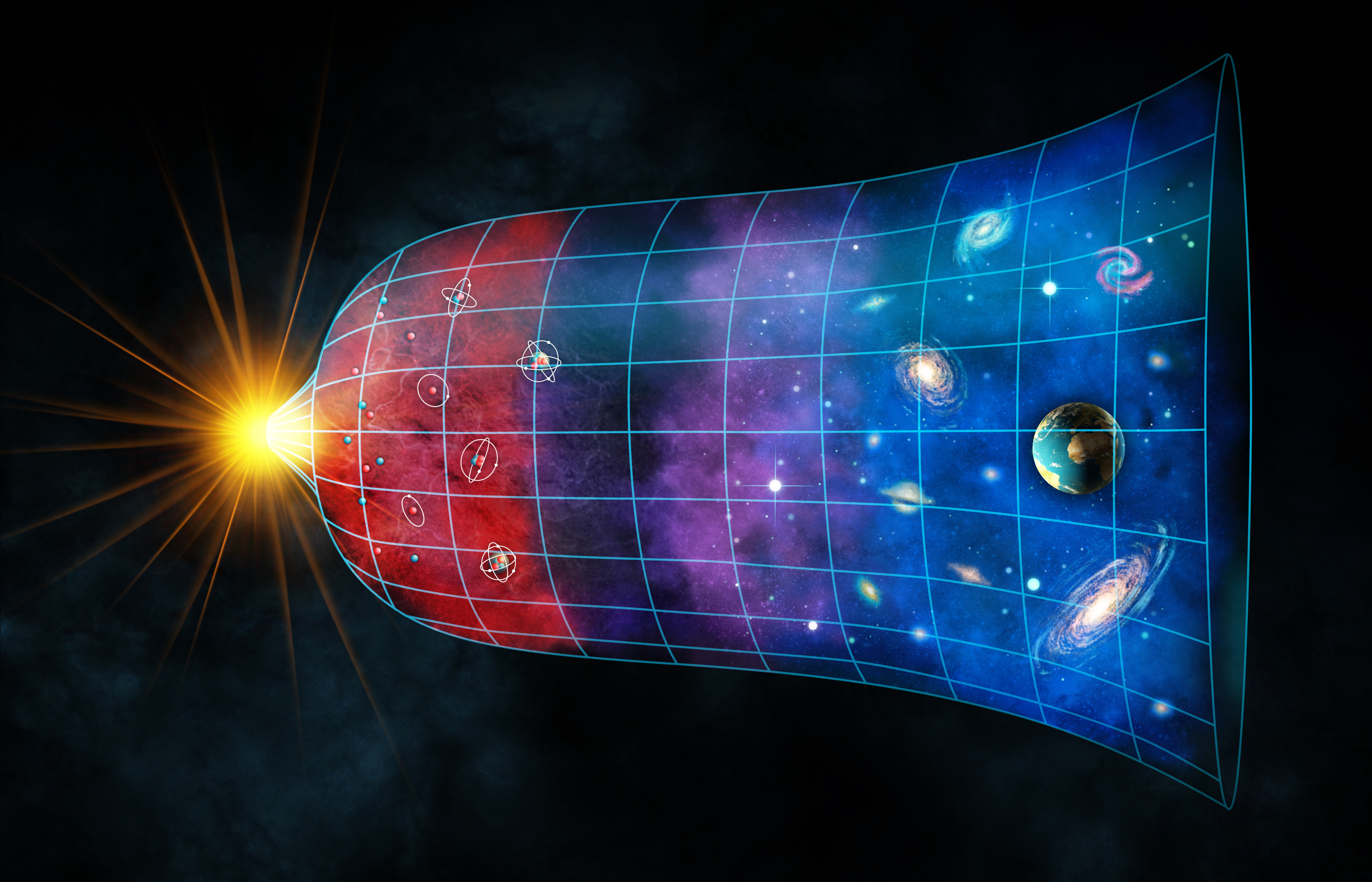The Big Bang Theory!

Say that you are a mad scientist with an enormous God complex, and you want your next creation to be another universe that mimics our current one. How would you go about doing that?
According to the Big Bang theory, you would have to start with what scientists call the gravitational singularity. This is an infinitesimally compact, infinitely dense, infinitely hot point with no dimensions, containing all of space, time, energy and matter. This is a point where all our present-day concepts of space-time and all our laws of physics in general stop making sense. This singularity, over time, starts to expand and cool down.
The expansion explained solely by the Big Bang theory wouldn’t lead to a universe just like ours because this theory leaves several unanswered questions, such as
- The horizon problem: How does the Cosmic Microwave Background (CMB), which is the radiation remnant from the early instants of the Big Bang that we can still detect, have the same temperature—within 10-5 kelvin—from all directions when there wasn’t enough time for the information about the temperature to be transferred from one end of the expanse to the other if it wasn’t traveling faster than the speed of light?
- The flatness problem: Why do we observe the “Goldilocks effect”? In other words, how is it that the density of matter and energy happens to be exactly right for there to be a flat universe? If it was even a little bit over-dense, the universe would collapse onto itself in a Big Crunch, and in the case of an under-density, it would become too sparse for any structures such as galaxies to form.
- Baryogenesis: Why is there a predominance of matter over antimatter when the early density was thought to be equal for all particles?
- Density fluctuations: How were these pockets of higher density—where the galaxies and their clusters later arose—formed?
- Missing relics: Where are the heavy, stable particles, like magnetic monopoles, that the unified gauge theories predict should be present as relics from the Big Bang even now, since they should have survived the annihilation?
In order to answer some of these questions, the Inflationary theory was introduced by Alan Guth in 1980. According to this theory, within the first 10–37 to 10–32 seconds of the “Big Bang,” the universe expanded exponentially to 1026 times its former size! In a single stroke, this theory addressed most of the issues anticipated by the Big Bang theory. It explains that the regions in the cosmic microwave background that are seemingly extremely far away are not causally disconnected, but were connected before inflation ever happened, and hence have the same temperature. Inflation would then have made the regions appear much farther off in the CMB radiation. This solves the horizon problem.
Now, on to the flatness problem. Inflation suggests that the universe is so large, actually 1023 times bigger than the observable universe, that its geometry becomes almost flat, in just the same way the Earth appears to be flat to us because, at our scale, we cannot sense its curvature. This also solves the problem of the missing relics in that the immense size of the universe makes the probability of finding such relics miniscule. The inflationary model also helps us explain the presence of the density fluctuations, with the help of a concept called quantum fluctuations in subatomic scales at very early stages of the universe. These fluctuations were the starting points of the incredible structures of the galaxies and their clusters that we see today!
Okay, so now you start off building your universe from the singularity. This point of singularity is all there is to your universe. There is no space, no vacuum around it. During the first second of the creation of your universe, the four fundamental forces of nature — gravitational, electromagnetic, strong nuclear and weak nuclear forces — that were united in the beginning start to separate from one another. This is followed by the formation of the elementary particles. Then comes the process of nucleosynthesis, at the temperature of 109 °C, in which nuclear fusion results in the formation of hydrogen, helium and a little bit of lithium nuclei. These processes last about 20 minutes. Then, for up to the first 240,000 years, the energy in the universe is dominated by radiation; this era is termed the radiation dominated era. The photons have no way of escaping from constant collisions with the nuclei surrounding them. However, as the universe cools, the nuclei begin to combine with the electrons to form neutral atoms. The Universe finally becomes transparent, and the photons are free to escape. We can still see the remnants of this epoch today through the Cosmic Microwave Background radiation! This epoch lasts about 300,000 years since the event of the Big Bang. Then comes the period of the Dark Ages, where there is little no light, and the universe is dominated by a mysterious substance called Dark Matter. This era lasts for about 150 million years and is followed by the Re-ionization era when the universe starts to form ions again. The first quasars appear! Stars, galaxies and galaxy clusters are created! This lasts for about 1 billion years. Our solar system took around 9 billion years to form and our universe is now around 13.7 billion years old.
What is the ultimate fate of the universe?
To get your universe to the state ours is in now, you would need to wait patiently for about 13.7 billion years. Then voila! You’d finally have the universe you set out to build! However, at this point, you might begin to have this nagging question on your mind: “What is the ultimate fate of this universe that I have created?” What indeed? At present, we don’t possess sufficient knowledge to be certain about how this will all end. We do know that, right now, our universe is expanding at an accelerated rate. Scientists explain this expansion through the presence of an invisible and hypothetical form of energy, which has the properties of repulsive gravity. This is called the Dark Energy. Depending on how much of this energy our universe contains, it could either expand forever, or gravity would finally manage to take over, and everything would contract into another singularity (the Big Crunch). In this case, we may live in a cyclic universe in which Big Bangs alternate with Big Crunches in a sequence of Big Bounces.
Depending on the geometry of the universe, there could be two ultimate endings. If the universe is flat or open, we would be geared towards a more dreadful and depressing ending. According to this theory, which is considered the most likely, our universe would continue to expand until there was no more energy left, and everything, life, stars, black holes and eventually atoms themselves, would ultimately disintegrate. The concept of time would lose its meaning since there would be no events taking place in this Big Freeze or “heat death.” Another theory suggests that the universe would continue expanding at an accelerated rate, leading to a so-called Big Rip that would tear it apart and ultimately cause it to decay into radiation.
It is interesting to note that for our universe to exist so many initial conditions had to be “just right.” How could this be? To some people, the answer may be found in the anthropic principle, according to which the universe and ultimately life as we know it, exist precisely because we are here to observe it. Others hypothesize the presence of multiple parallel universes, the multiverse theory, according to which there may be an infinity of universes present along with our own, each having their own set of laws of physics, with different initial conditions than our universe. We just happen to be in one where life could form!
Want to know more about the Big Bang and the cosmic inflation? Since this is a fairly complex topic, we have put together a series of videos from Paul Sutter, an astrophysicist at The Ohio State University in Columbus, Ohio.






